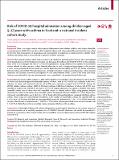Risk of COVID-19 hospital admission among children aged 5–17 years with asthma in Scotland : a national incident cohort study
Abstract
Background There is an urgent need to inform policy deliberations about whether children with asthma should be vaccinated against SARS-CoV-2 and, if so, which subset of children with asthma should be prioritised. We were asked by the UK's Joint Commission on Vaccination and Immunisation to undertake an urgent analysis to identify which children with asthma were at increased risk of serious COVID-19 outcomes. Methods This national incident cohort study was done in all children in Scotland aged 5–17 years who were included in the linked dataset of Early Pandemic Evaluation and Enhanced Surveillance of COVID-19 (EAVE II). We used data from EAVE II to investigate the risk of COVID-19 hospitalisation among children with markers of uncontrolled asthma defined by either previous asthma hospital admission or oral corticosteroid prescription in the previous 2 years. A Cox proportional hazard model was used to derive hazard ratios (HRs) and 95% CIs for the association between asthma and COVID-19 hospital admission, stratified by markers of asthma control (previous asthma hospital admission and number of previous prescriptions for oral corticosteroids within 2 years of the study start date). Analyses were adjusted for age, sex, socioeconomic status, comorbidity, and previous hospital admission. Findings Between March 1, 2020, and July 27, 2021, 752 867 children were included in the EAVE II dataset, 63 463 (8·4%) of whom had clinician-diagnosed-and-recorded asthma. Of these, 4339 (6·8%) had RT-PCR confirmed SARS-CoV-2 infection. In those with confirmed infection, 67 (1·5%) were admitted to hospital with COVID-19. Among the 689 404 children without asthma, 40 231 (5·8%) had confirmed SARS-CoV-2 infections, of whom 382 (0·9%) were admitted to hospital with COVID-19. The rate of COVID-19 hospital admission was higher in children with poorly controlled asthma than in those with well controlled asthma or without asthma. When using previous hospital admission for asthma as the marker of uncontrolled asthma, the adjusted HR was 6·40 (95% CI 3·27–12·53) for those with poorly controlled asthma and 1·36 (1·02–1·80) for those with well controlled asthma, compared with those with no asthma. When using oral corticosteroid prescriptions as the marker of uncontrolled asthma, the adjusted HR was 3·38 (1·84–6·21) for those with three or more prescribed courses of corticosteroids, 3·53 (1·87–6·67) for those with two prescribed courses of corticosteroids, 1·52 (0·90–2·57) for those with one prescribed course of corticosteroids, and 1·34 (0·98–1·82) for those with no prescribed course, compared with those with no asthma. Interpretation School-aged children with asthma with previous recent hospital admission or two or more courses of oral corticosteroids are at markedly increased risk of COVID-19 hospital admission and should be considered a priority for vaccinations. This would translate into 9124 children across Scotland and an estimated 109 448 children across the UK.
Citation
Shi , T , Pan , J , Katikireddi , S V , McCowan , C , Kerr , S , Agrawal , U , Shah , S A , Simpson , C R , Ritchie , L D , Robertson , C , Sheikh , A & Public Health Scotland and the EAVE II Collaborators 2021 , ' Risk of COVID-19 hospital admission among children aged 5–17 years with asthma in Scotland : a national incident cohort study ' , The Lancet Respiratory Medicine , vol. In press . https://doi.org/10.1016/S2213-2600
Publication
The Lancet Respiratory Medicine
Status
Peer reviewed
ISSN
2213-2600Type
Journal article
Description
Authors thank the EAVE II Patient Advisory Group for their support. EAVE II is funded by the Medical Research Council (MR/R008345/1) with the support of BREATHE—The Health Data Research Hub for Respiratory Health (MC_PC_19004)—which is funded through the UK Research and Innovation Industrial Strategy Challenge Fund and delivered through Health Data Research UK. Additional support has been provided through Public Health Scotland and Scottish Government Director-General Health and Social Care and the Data and Connectivity National Core Study, led by Health Data Research UK in partnership with the Office for National Statistics and funded by UK Research and Innovation. SVK acknowledges funding from an NHS Research Scotland Senior Clinical Fellowship (SCAF/15/02), the Medical Research Council (MC_UU_00022/2) and the Scottish Government Chief Scientist Office (SPHSU17).Collections
Items in the St Andrews Research Repository are protected by copyright, with all rights reserved, unless otherwise indicated.

